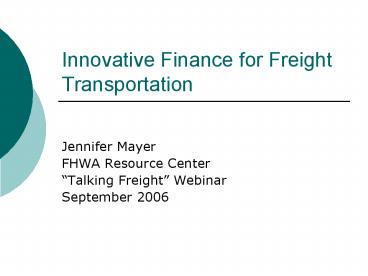Innovative Finance for Freight Transportation - PowerPoint PPT Presentation
1 / 17
Title:
Innovative Finance for Freight Transportation
Description:
How Do Freight Projects Qualify for Innovative Finance? ... Federal-aid eligibility opens the door to innovative finance eligibility ... – PowerPoint PPT presentation
Number of Views:53
Avg rating:3.0/5.0
Title: Innovative Finance for Freight Transportation
1
Innovative Finance for Freight Transportation
- Jennifer Mayer
- FHWA Resource Center
- Talking Freight Webinar
- September 2006
2
Freight in the Federal-Aid Highway Program
- Historically, federal transportation funding has
been divided by mode - Unfortunately, there is no Federal Freight
Administration - Over the past 2 decades, eligibility for freight
and intermodal projects has been substantially
expanded - Latest transportation bill (SAFETEA-LU) continues
this trend
3
Freight Eligibility Under Title 23
- Example projects
- Intermodal freight facilities on the National
Highway System - Rail-highway hazard elimination
- Emissions reduction projects under the Congestion
Mitigation and Air Quality program - Eligibility is only a hunting license for the
funds - Project sponsors still have to work with regional
bodies known as Metropolitan Planning
Organizations, State DOTs, and FHWA Division
office to secure funding and approvals
4
Truck Parking Facilities Program
- Address shortage of long-term truck parking on
the National Highway System - 6.25 million annually through 2009.
- Applications must be submitted to FHWA Division
Office by November 27, 2006 - Questions concerning this program should be
addressed to William Mahorney, 202-366-6817
(Bill.Mahorney_at_dot.gov), or to Julie Strawhorn,
202-366-4415 (Julie.Strawhorn_at_dot.gov) of the
Office of Freight Management and Operations.
5
How Do Freight Projects Qualify for Innovative
Finance?
- If you could assist with a Federal-aid funding
directly, you can assist with IF tools - Federal-aid eligibility opens the door to
innovative finance eligibility - Generally, FHWA Division has the final call on
eligibility, and should be first point of contact
6
What is Innovative Finance?
- Tools that help leverage funding
- Tools that attract other funding
- Tools that facilitate access to other funding
(e.g., the capital markets, private equity) - Any tool (other than traditional grants) that
helps to get projects financed
7
Three Leading IF Tools
- State Infrastructure Bank (SIB)
- Transportation Infrastructure Finance and
Innovation Act (TIFIA) - Private Activity Bond (PAB)
8
State Infrastructure Bank (SIB)
- Provides loans, lines of credit, and other forms
of credit enhancement to projects that qualify
for Federal-aid - State-Controlled, but created with Federal-aid
funding - 32 states have them all states and territories
may create them
9
How Would a SIB Loan Work?
Project sponsor applies to State SIB for loan for
rail-highway crossing elimination project
The SIB considers the loan application (If the
SIB does not currently have funds, it may choose
to use some of its Federal-aid funding to
capitalize (fund) the SIB loan)
If the application is approved, the SIB and the
borrower negotiate terms such as interest rate,
term of loan, and collateral, then the loan is
made.
The borrower constructs the project and repays
the loan
The SIB uses the repayments to assist other
projects.
10
Advantage of SIB Loans To Borrowers, and to
State DOTs
- State DOTs
- Assist more than one project with the repaid
funds (repayments go back in the program) - Leverage loans and credit enhancement go
farther than direct Federal-aid - Attract net new money to the system
- Borrowers
- Low interest rate (zero to market)
- Flexible repayment
- Maximum 35 year term
- Repayments can be delayed up to five years after
construction - Patient lender (can be subordinate)
11
Transportation Infrastructure Finance and
Innovation Act (TIFIA)
- Provides loans, lines of credit, and other forms
of credit enhancement to large projects,
including intermodal freight facilities - Apply directly to USDOT
12
How Would a TIFIA Loan Work?
Project sponsor applies to USDOT for loan for
intermodal highway/rail facility
USDOT considers the loan application
If the application is approved, USDOT and the
borrower negotiate terms such as repayment
schedule, term of loan, and collateral, then the
loan is made
The borrower constructs the project and repays
the loan
USDOT modes monitor project for compliance with
Federal requirements
13
Advantage of TIFIA Loans To Borrowers, and USDOT
- USDOT
- Leverage (can assist more projects with loans and
credit enhancement) - Attract net new money to the system
- Enable/facilitate public private partnerships
- Borrowers
- Low interest rate (Treasury)
- Flexible repayment
- Maximum 35 year term
- Repayments can be delayed up to five years after
construction - Patient lender (can be subordinate)
14
Private Activity Bonds (PABs)
- Allows tax-exempt bonds to be issued for projects
with private involvement - Does not provide funds or loan but allows
sponsors to access capital market funds at
cheaper interest rates - Apply directly to USDOT
15
How Would a PAB Work?
Project sponsor applies to USDOT for allocation
of PAB authority
USDOT considers the application
If the application is approved, USDOT and the
project sponsor work to find a conduit issuer.
The issuer issues the bonds, and provides
proceeds to sponsor. Sponsor constructs project
and makes payments.
USDOT modes monitor project for compliance with
Federal requirements
16
Advantage of PABs To Sponsors and USDOT
- USDOT
- Attract net new money to the system
- Enable/facilitate public private partnerships
- Sponsors
- Cheaper financing (often 1-2 percentage points
cheaper than taxable private finance) - May facilitate financing packages
17
Additional Resources on IF
- Jennifer Mayer, FHWA Resource Center Innovative
Finance Team - jennifer.mayer_at_fhwa.dot.gov (415)744-2634
- TIFIA http//tifia.fhwa.dot.gov
- SIBs www.fhwa.dot.gov/innovative
finance/sibs.html - PABs www.fhwa.dot.gov/ppp































